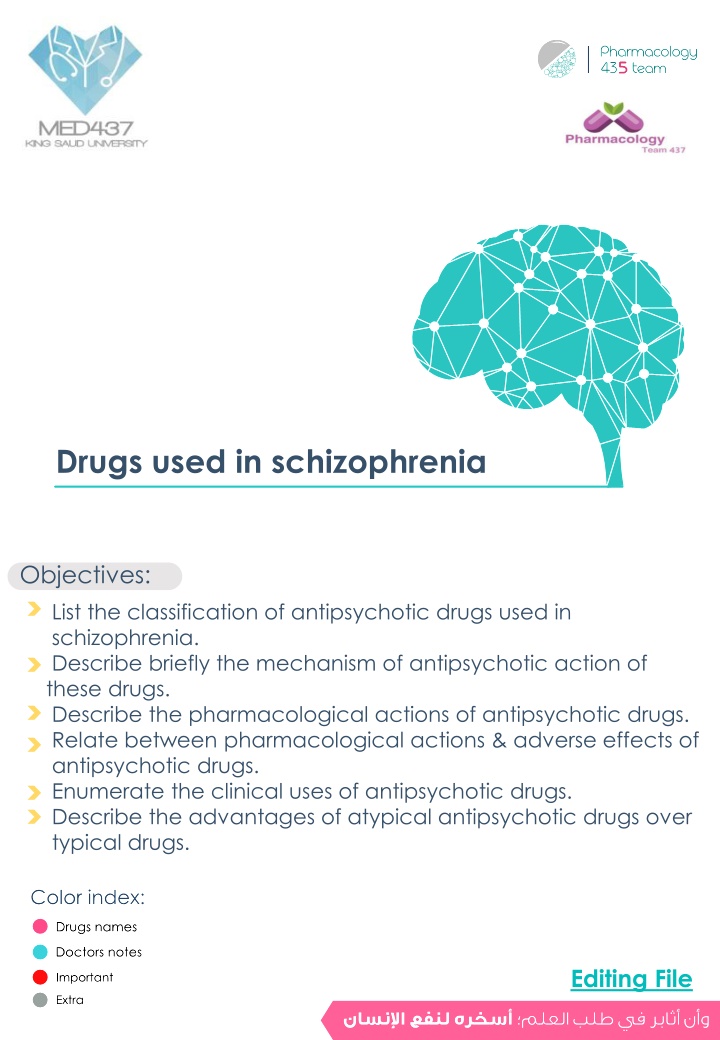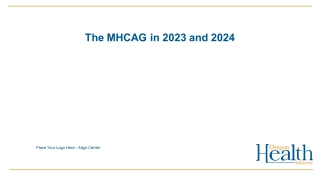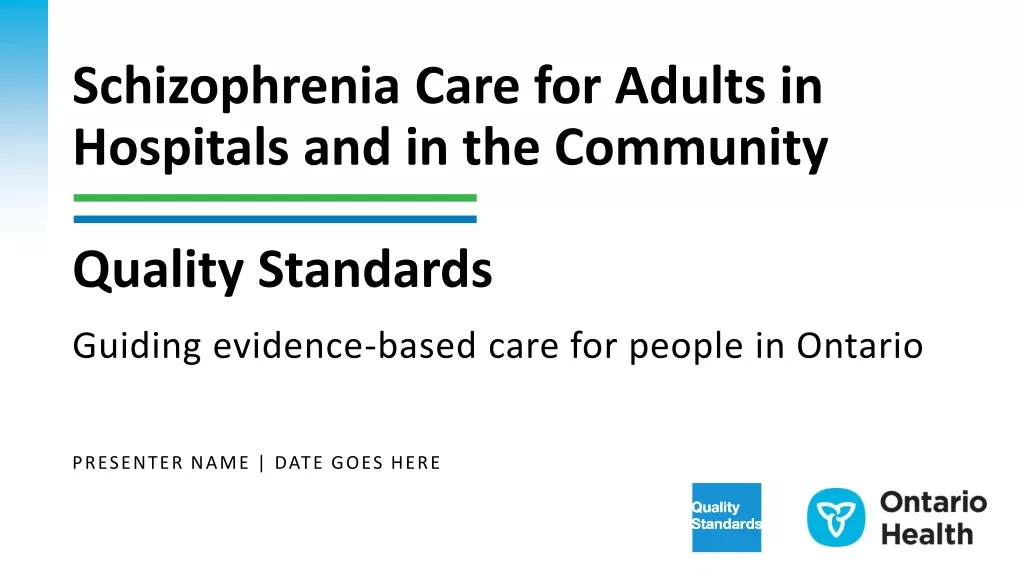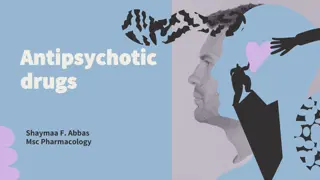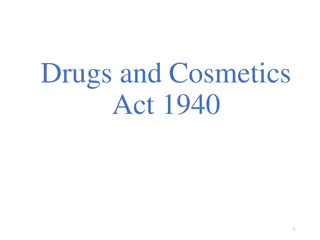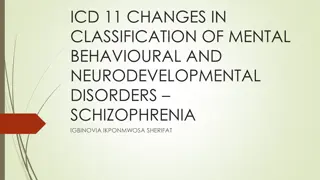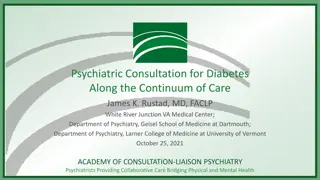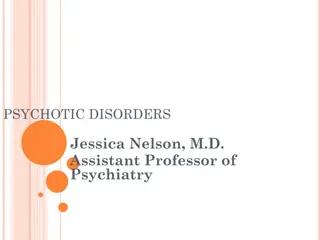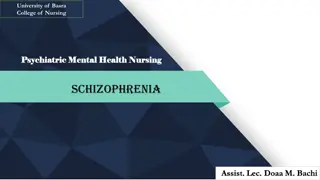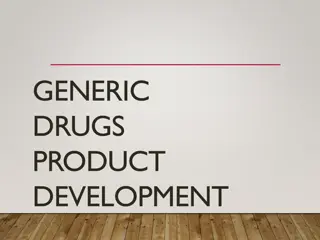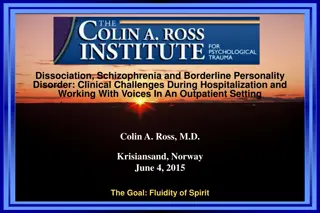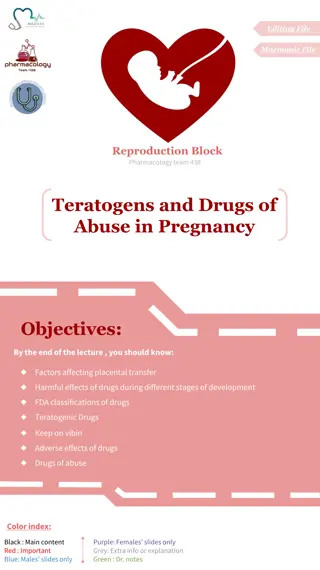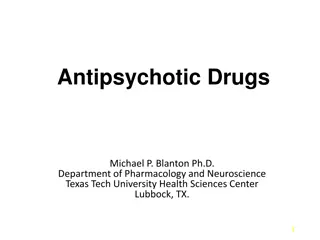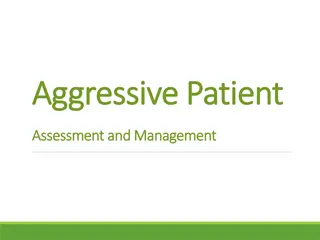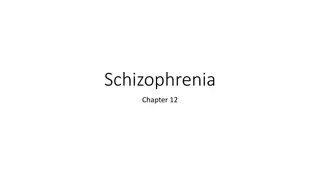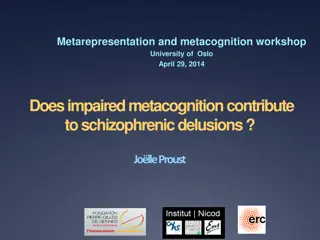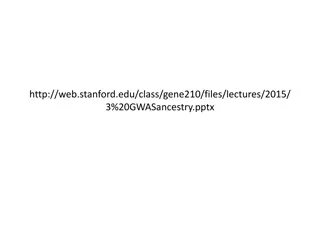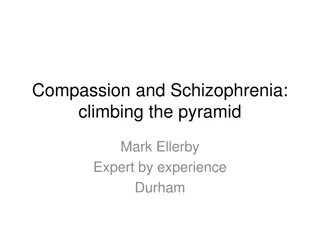Antipsychotic Drugs in Schizophrenia
This content provides comprehensive information on antipsychotic drugs used in schizophrenia, including classification, mechanisms of action, pharmacological actions, adverse effects, clinical uses, and advantages of atypical drugs over typical ones. It delves into the dopaminergic pathways, receptor actions, and the differences between typical and atypical antipsychotic medications.
Download Presentation

Please find below an Image/Link to download the presentation.
The content on the website is provided AS IS for your information and personal use only. It may not be sold, licensed, or shared on other websites without obtaining consent from the author.If you encounter any issues during the download, it is possible that the publisher has removed the file from their server.
You are allowed to download the files provided on this website for personal or commercial use, subject to the condition that they are used lawfully. All files are the property of their respective owners.
The content on the website is provided AS IS for your information and personal use only. It may not be sold, licensed, or shared on other websites without obtaining consent from the author.
E N D
Presentation Transcript
Drugs used in schizophrenia Objectives: List the classification of antipsychotic drugs used in schizophrenia. Describe briefly the mechanism of antipsychotic action of these drugs. Describe the pharmacological actions of antipsychotic drugs. Relate between pharmacological actions & adverse effects of antipsychotic drugs. Enumerate the clinical uses of antipsychotic drugs. Describe the advantages of atypical antipsychotic drugs over typical drugs. Editing File 0
Psychoses Schizophrenia Mania Psychoses Affective Psychoses Depression Manic-depressive illness (Bipolar affective disease) Schizophrenia Definition: It is a thought disorder characterized by divorcement from reality in mind of patient. it may involve hallucinations, delusions , intense suspicion, feeling of persecution or control by external forces (paranoia) Feeling that someone is controlling you (Paranoia). Positive symptoms(Related to dopamine): 1- hallucinations 2- Delusions 3- paranoia. Old group (typical) and new group are effective here Negative symptoms (Related to serotonin) : 1- Social withdrawal 2- Anhedonia (absence of pleasure) 3-Emotional blunting -Old group won't work here, the new group only , also negative symptoms are more difficult to treat. Dopamine system & receptors Dopamine pathway in the brain: Behavior 1- Mesolimbic-mesocortical pathway 2- Nigrostriatal pathway coordination of voluntary movements 3- Tuberoinfundibular pat endocrine effects metabolic effects 4- Medullary - periventricular pathway Dopaminergic pathways in the brain: There are at least five subtypes of Dopamine receptors: D1, D2, D3, D4, D5.
Antipsychotic drugs overview - Drugs used in schizophrenia are classified according to chemical structures Into: Typical Atypical more selective, less side effects, 1stline treatment for schizophrenia. discovered first, non selective, many side effects, rarely used nowadays. Classification of Antipsychotic Typical Antipsychotic Drugs affect D2 mainly treat the +ve symptoms. Phenothiazine derivatives Its chemical structure similarto TCAs similar ADRs Chlorpromazine, Thioridazine Butyrophenones Haloperidol Thioxanthene Thiothixene Atypical Antipsychotic Drugs Affect both DA & 5-HT receptors treat +ve & -ve symptoms. Dibenzodiazepines* Clozapine Benzisoxazoles* Risperidone Thienobenzodiazepines* Olanzapine Dibenzothiazepines* Quetiapine Benzisothiazoles* Ziprasidone piperazine/piperidine derivatives* Cariprazine *Prof.Yieldez said: it s enough to know the drug name only like (Clozapine, Risperidone , ..) The pharmacological actions of antipsychotic drugs result from: - Blocking dopamine receptors at different areas in the brain. - Blocking muscarinic receptors - Blocking -adrenergic receptors - Blocking H1 receptors Adverse effects on CNS Advantages of Atypical drugs They are due to blocking dopamine receptors at areas other than mesolimbic area (extrapyramidal effects) They block both dopaminergic & serotonergic receptors. They are effective in refractory cases of schizophrenia. They produce few extrapyramidal effects.
Pharmacological actions of typical & atypical anti-psychoses typical & atypical pharmacological actions receptor , . Before starting the pharmacological actions we need to be familiar with these concepts: - Psychomotor slowing: involves a slowing-down of thought and a reduction of physical movements in an individual. - Psychotic disorder: abnormal thinking and perceptions. - Agitation: a state of anxiety or nervous excitement. - Tardive dyskinesia: a neurological disorder characterized by involuntary movements of the face and jaw. - Galactorrhea: excessive or inappropriate production of milk. - Amenorrhea: an abnormal absence of menstruation. - Gynecomastia: enlargement of a man's breasts, usually due to hormone imbalance or hormone therapy. - Impotence: inability to develop or maintain an erection of the penis during sexual activity in humans. - Pruritus: severe itching of the skin. CNS ANS Antipsychotic effect: (it s the main use) - Produce emotional quieting and psychomotor slowing. - Decreasing hallucinations, delusions and agitation. Mechanism: blockage of dopamine receptors in the mesolimbic system. treat +ve symptoms. Note: Atypical drugs exert their antipsychotic action through blocking serotonergic (5HT2) and dopaminergic receptors. treat ve symptoms also. Anticholinergic effects: - Blurred vision - Dry mouth - Urinary retention - Constipation Mechanism: blockage of muscarinic receptors. Extrapyramidal symptoms: - Abnormal involuntary movements such as tremors, parkinsonism, and tardive dyskinesia. Mechanism: blockage of dopamine receptors in the nigrostriatum. Ach more than dopamine Antiadrenergic effects: - Postural hypotension - Impotence - failure of ejaculation. Mechanism: blockage of alpha-adrenergic receptors. Endocrine effects: - Galactorrhea - Amenorrhea - Gynecomastia & impotence. Mechanism: prevent dopamine from inhibiting prolactin release from pituitary gland and that will lead to hyperprolactinemia. .
Pharmacological actions Cont. CNS Other Metabolic effect: - Changes in eating behavior and weight gain. Mechanism: blockage of dopamine receptors in the medullary- periventricular pathway. Temperature regulation: May cause lowering of body temp. Mechanism: heat loss as a result of vasodilation due to alpha-blocking or to central effect. (In major operations; open heart surgery) ECG changes: prolongation of QT interval, abnormal configuration ST segment and T wave. Too prolongation will lead to Torsades de pointes which may lead to ventricular fibrillation Antihistaminic effect: sedation due to H1 receptor blockage. Antiemetic effect: - Effective against drug and disease- induced vomiting. (not-motion sickness) Mechanism: blockage of dopamine receptors in the CTZ of the medulla. The chemoreceptor trigger zone (CTZ) is an area of the medulla oblongata that receives inputs from blood-borne drugs or hormones, and communicates with other structures in the vomiting center to initiate vomiting. Quinidine-like action = postural hypotension Chlorpromazine
Adverse Effects typical and atypical pharmacological action So most of the pharmacological actions = adverse effects Prof.Yieldez said: we will ask about the characteristic ADRs of each drug. CNS 1- Sedation, drowsiness, fatigue (haloperidol (typical) , Risperidone (atypical) ) 2- Extrapyramidal symptoms: Early occurring: Parkinson s syndrome, late occurring: A) Tardive Dyskinesia B) Neuroleptic Malignant Syndrome (from Latin tardus, slow or late coming) It is a disorder of involuntary movements (choreoathetoid movements of lips, tongue, face, jaws, and limbs ) Choreoathetosis: combination of chorea (irregular migrating contractions) and athetosis (twisting) Rare but life threatening. Symptoms are muscle rigidity and high fever (clinically similar to anaesthetic malignant hyperthermia). The stress leukocytosis and high fever associated with this syndrome may wrongly suggest an infection. Neuroleptic malignant syndrome ANS 1- Anticholinergic Effects : 2- Antiadrenergic Effects : - Blurred vision - Dry mouth - Urinary retention - Constipation (Chlorpromazine (typical), Clozapine (atypical)) - Postural hypotension - Impotence - Failure of ejaculation (Chlopromazine (typical), Thioridazine (typical)) Endocrine Effects Gynecomastia Galactorrhoea Amenorrhoea
Adverse Effects Cont. *These ADRs are not related to the drug itself , but related to the genetic susceptibility of person to have these ADRs when he/she take the drugs Miscellaneous Effects * Obstructive jaundice Chlorpromazine Retinal deposits (thioridazine) Granular deposits in cornea Weight gain The only one Clozapine Agranulocytosis - About 1-2% - Usually happen after 6-18 weeks - Weekly WBC is mandatory (increase susceptibility to have infections) - Seizures Agranulocytosis, also known as agranulosis or granulopenia, is an acute condition involving a severe and dangerous leukopenia (lowered white blood cell count) Therapeutic uses Psychiatric Non-psychiatric - Nausea and vomiting. Prochloroperazine and benzquinamide are only used as antiemetics. Pruritus ( ) Schizophrenia (primary indication). Acute mania. Manic-depressive illness (bipolar affective disorder) during the manic phase. Bipolar affective disorder is characterized by periods of deep, prolonged, and profound depression that alternate with periods of an excessively elevated or irritable mood known as mania. Preoperative sedation. (Rare use) How Do Antipsychotic Drugs Work? How Effective are Medications for Schizophrenia & Psychosis? Pharmacokinetics: Incompletely absorbed. Highly lipid soluble. Highly bound to plasma proteins. Undergo extensive first-pass hepatic metabolism. Excretion by the kidney.
Atypical Antipsychotics - 2ndGeneration antipsychotics - First line treatments for schizophrenia - Little or no extrapyramidal side effects - Effective in treatment of resistant schizophrenia. - Are effective on both positive & negative symptoms. - Block both dopaminergic & serotonergic receptors. Clinical uses: - Refractory cases of schizophrenia. - To reduce the risk of recurrent suicidal behavior in patients with schizophrenia. Risperidone Ziprasidone Cariprazine MOA: Blocks D2 & 5HT2 receptors. Main adverse effects: - Drowsiness, Akathisia (cant keep still) ,Headache ,Dizziness, Weight gain. Drug interactions: - Should not be used with any drug that prolongs the QT interval. - Activity decreased by carbamazepine (inducer of CYP3A4) - Activity increased by ketoconazole (antifungal) (inhibitor of CYP3A4) Important: It increases mortality in elderly patients with dementia-related psychosis. Olanzapine MOA: Blocks D2& 5HT2 receptors. - approved in 2015 by the FDA - has higher affinity at D3 receptor - has a positive impact on the cognitive symptoms of schizophrenia Main adverse effects: - Postural hypotension - QT prolongation - Weight gain Contraindicated: Patients with long QT interval. Imp to know drug interactions Clozapine Quetiapine MOA: Blocks D1- D4& 5HT2 receptors. MOA: Blocks both D4& 5HT2receptors. Main adverse effects: - Agranulocytosis - Seizures - Myocarditis - Excessive salivation (during sleep) MOA: Blocks D1-D2& 5HT2receptors. Main adverse effects: - Sedation - Hypotension - Sluggishness - Dry mouth - Increased appetite (weight gain) - Abdominal pain - Constipation Main adverse effects: - Weight gain - Sedation - Flatulence, increased salivation & thirst. - Postural hypotension.
Summary Pharmacological Actions M.O.A Effect S/E Emotional quieting & psychomotor slowing. hallucinations, delusions and agitation. Block of DA receptors in the mesolimbic system. - Antipsychotic effect Block of DA receptors in the nigrostriatum Abnormal involuntary movements Tardive Dyskinesia Parkinson s syndrome Neuroleptic Malignant Syndrome Extrapyramidal effect Prevent DA from inhibiting prolactin release from pituitary Hyperprolactinemia Galactorrhea, Amenorrhea, Gynecomastia & impotence. Endocrine effects Blockade of DA receptors in the medullary periventricular pathway Changes in eating behavior and weight gain - Metabolic effects Blockade of DA receptors in the CTZ of the medulla Effective against drug & disease- induced vomiting (NOT motion sickness) Prochlorperazine and Benzquinamide are only used as antiemetics Anti-emetic effect - Blurred vision - Constipation - Dry mouth - Urinary retention Blockade of muscarinic receptors Anticholinergic Effects Caused mainly by Chlorpromazine , Clozapine - Postural hypotension - Impotence - Failure of ejaculation Blockade of - adrenergic receptors Antiadrenergic Effects Caused mainly by Chlopromazine , Thioridazine Heat loss as a result of vasodilation ( - blocking ) Or due to central effect May cause lowering of body temperature Uses: in major surgeries like open heart surgery Temperature regulation Prolongation of QT interval Abnormal configuration of ST- segment & T wave. #cardiac patient ECG changes Like: Risperidone - Ziprasidone Sedation due to H1 receptor blockade - Antihistaminic effect - It causes arrhythmia - Quinidine like actions Obstrucive jaundice. Granular deposits in cornea. Retinal deposits (thioridazine) Weight gain. Miscellaneous Effects - -
Summary Atypical Antipsychotics: acts on both dopaminergic & serotonergic - first line treatment Duge Cariprazin e Clozapine Risperidone Olanzapine Quetiapine Ziprasidone Blocks D4 & 5HT2 receptors Blocks D2 & 5HT2 receptors Blocks D1- D4 & 5HT2 receptors Blocks D1- D2 & 5HT2 receptors Blocks D2 & 5HT2 receptors D3 receptor M.O.A Agranulocytosi s Seizures Myocarditis Excessive salivation (during sleep) Postural hypotension QT prolongation Weight gain Sedation (also haloperidol) Weight gain Sedation Flatulence, salivation & thirst Postural hypotensio n Sedation Hypotensio n Sluggishnes s Dry mouth Increased appetite (weight gain) Abdomina l pain Constipatio n Drowsiness Akathisia Headache Dizziness Weight gain S/E in patients with long QT interval cardiac patient mortality in elderly patients, with dementia- related psychosis C/I - - - should not be used with any drug that prolongs the QT interval. Activity by carbamazep ine(inducer of CYP3A4). Activity by ketoconazole (inhibitor of CYP3A4) Drug interactions - - - -
Questions MCQs Q1/Side effects include anti-cholinergic, anti-adrenergic and extrapyramidal? A-haloperidol B-lithium C-meprobamate D-chloral hydrate Q2/which of the following is the mechanism of action of Clozapine? A-Blocks D1-D4 & 5HT2 receptor B-Blocks D4 & 5HT2 receptor C-Blocks D1-D2 & 5HT2 receptor D-Blocks D2 & 5HT2 receptor Q3/which of the following is an antiemetic effect in the CNS? A-sedation due to H1 receptor blockage B-Galactorrhea C-Effective against drug and disease-induced vomiting. (not-motion sickness) D-Blurred vision Q4/ Which of the following is an advantage of atypical drugs? A-they may cause lowering of body temperature B-They are not effective in refractory cases of schizophrenia C-They block both dopaminergic & serotonergic receptors D-They don t produce few extrapyramidal effects Q5/which of the following drugs can produce constipation? A-Risperidone B-Thioridazine C-Chlorpromazine D-haloperidol MCQs Answers: 1-A 2-B 3-C 4-C 5-C
Questions MCQs Q6/which of the following is a positive symptom of Schizophrenia? A-Social withdrawal B-Delusions C-Emotional blunting D-Anhedonia (absence of pleasure) Q7/Which of the following is a atypical antipsychotic drug? A-Thiothixene B-Thiothixene C-Chlorpromazine D-Olanzapine Q8/ which of the following is non-psychiatric therapeutic use? A-Acute mania B-Schizophrenia (primary indication) C-Manic-depressive illness D-Pruritus MCQs Answers: 6-B 7-D 8-D SAQ Q1/A 17 year old male diagnosed with schizophrenia and was treated with haloperidol,can you name three adverse effects for this drug? Sedation, drowsiness, and fatigue. Q2/ A 35-year-old man with abnormal behavior has been diagnosed with schizophrenia A-what is the definition of of schizophrenia? It is a disorder characterized by divorcement from reality in mind of patient and it may involve hallucinations, delusions , intense suspicion, feeling of persecution or control by external forces (paranoia). B-Can you name three negative and positive symptoms of schizophrenia? Positive symptoms :1- hallucinations 2- Delusions 3- paranoia Negative symptoms :1- Social withdrawal 2- Anhedonia (absence of pleasure) 3-Emotional blunting.
Team leaders: Ghaida Saad Alsanad Omar Alsuhaibani Team Members: Dana Alkadi Ghada Alqarni Dimah Alaraifi Sara Alsultan Hind Aloraier Alanoud Almufarrej Alanoud Almansour Shahad Altayash References: - Doctors slides and notes. - Pharmacology Team 435. Special thank for team 435 @Pharma4370 Pharm437@gmail.com
